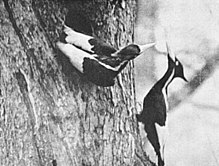
Back نقار الخشب ذو المنقار العاجي Arabic نقار الخشب منقار العاج ARZ Белоклюн кълвач Bulgarian Campephilus principalis Breton Picot negre bec d'ivori Catalan Campephilus principalis CEB Datel knížecí Czech Cnocell fwyaf America Welsh Elfenbeinspecht German Eburbeka pego Esperanto
| Ivory-billed woodpecker | |
|---|---|

| |
| Photograph of a male ivory-billed woodpecker leaving the nest as the female returns, taken on the Singer Tract, Louisiana, April 1935, by Arthur A. Allen | |
| Scientific classification | |
| Domain: | Eukaryota |
| Kingdom: | Animalia |
| Phylum: | Chordata |
| Class: | Aves |
| Order: | Piciformes |
| Family: | Picidae |
| Genus: | Campephilus |
| Species: | C. principalis
|
| Binomial name | |
| Campephilus principalis | |
| Subspecies | |
| |

| |
| Estimated range of the ivory-billed woodpecker prior to 1860 (solid line) and in 1891 (hatched area) – by Edwin Hasbrouck | |
| Synonyms | |
|
Picus principalis Linnaeus, 1758 | |
The ivory-billed woodpecker (Campephilus principalis) is a woodpecker native to the bottomland hardwood forests and temperate coniferous forests of the Southern United States and Cuba.[a] The US Fish and Wildlife Service proposed listing it as extinct September 29, 2021. Habitat destruction and hunting have reduced populations so thoroughly that the species is listed by the International Union for Conservation of Nature (IUCN) on its Red List as critically endangered,[1][3] and by the American Birding Association as "definitely or probably extinct".[4] The last universally accepted sighting of an American ivory-billed woodpecker occurred in Louisiana in 1944, and the last universally accepted sighting of a Cuban ivory-billed woodpecker occurred in 1987, after the bird's rediscovery there the prior year.[5][6][7] Sporadic reports of sightings and other evidence of the persistence of the species have continued since then.
The bird's preferred diet consists of large beetle larvae, particularly wood-boring Cerambycidae beetles, supplemented by vegetable matter, including such varied fruits as southern magnolia, pecans, acorns, hickory nuts, wild grapes, and persimmons. To hunt wood-boring beetle larvae, the bird uses its large bill to wedge and peel bark off dead trees to expose the larvae tunnels; no other species present in its range can remove tightly bound tree bark, and the ivory-bill faces no real competitor in hunting these larvae.
It is the largest woodpecker in the United States, and one of the largest in the world, with a total length of 48 to 53 cm (19 to 21 in) and a typical wingspan of 76 cm (30 in). In adults, the bill is ivory in color, hence the bird's common name, while it is chalky white in juveniles. The bird has been found in habitat including dense swampland, comparatively open old-growth forests, and, in Cuba, upland pine forests. Both parents work together to dig out a tree cavity roughly 15–70 feet (4.6–21.3 m) from the ground to create the nest, with a typical depth of approximately 50 cm (20 in).
In the 21st century, reported sightings and analyses of audio and visual recordings were published in peer-reviewed scientific journals as evidence that the species persists in Arkansas, Louisiana, and Florida. Various land purchases and habitat restoration efforts to protect surviving individuals have been initiated in areas where sightings and other evidence suggest a relatively high probability the species exists. In September 2021, the U.S. Fish and Wildlife Service (USFWS) [8] proposed that the species be declared extinct. However, following public comment periods, USFWS announced in a news release that it would continue to analyze and review information before finalizing any decision.
- ^ a b BirdLife International (2020). "Campephilus principalis". IUCN Red List of Threatened Species. 2020: e.T22681425A182588014. doi:10.2305/IUCN.UK.2020-3.RLTS.T22681425A182588014.en. Retrieved 19 November 2021.
- ^ "NatureServe Explorer 2.0". explorer.natureserve.org. Retrieved 28 March 2022.
- ^ "Ivory-billed Woodpecker Campephilus principalis". Archived from the original on 24 October 2018. Retrieved 24 October 2018.
- ^ "Annual Report of the ABA Checklist Committee: 2007 – Flight Path" (PDF). Archived (PDF) from the original on 4 December 2008. Retrieved 13 November 2012.
- ^ Eckholm, Erik (5 May 1986). "Woodpecker, Believed Extinct, Seen in Cuba". The New York Times. ISSN 0362-4331. Retrieved 3 July 2022.
- ^ "Day 1: The Journey Begins". Audubon. 11 April 2016. Retrieved 3 July 2022.
until 1986, when Lester Short of the American Museum of Natural History and his colleagues announced seeing Ivory-bills in the mountains of eastern Cuba...The last sighting in Cuba was in 1987.
- ^ LAMMERTINK, MARTJAN; ESTRADA, ALBERTO R. (1995). "Status of the Ivory-billed Woodpecker Campephilus principalis in Cuba: almost certainly extinct" (PDF). Bird Conservation International: 5:53–59 – via www.cambridge.org.
The Ivory-billed Woodpecker Campephilus principalis has suffered from destruction of its habitat over the whole of its range, being last recorded in eastern Cuba (Ojito de Agua) in 1987.
- ^ Einhorn, Catrin (29 September 2021). "Protected Too Late: U.S. Officials Report More Than 20 Extinctions". The New York Times. ISSN 0362-4331. Archived from the original on 29 September 2021. Retrieved 29 September 2021.
Cite error: There are <ref group=lower-alpha> tags or {{efn}} templates on this page, but the references will not show without a {{reflist|group=lower-alpha}} template or {{notelist}} template (see the help page).

